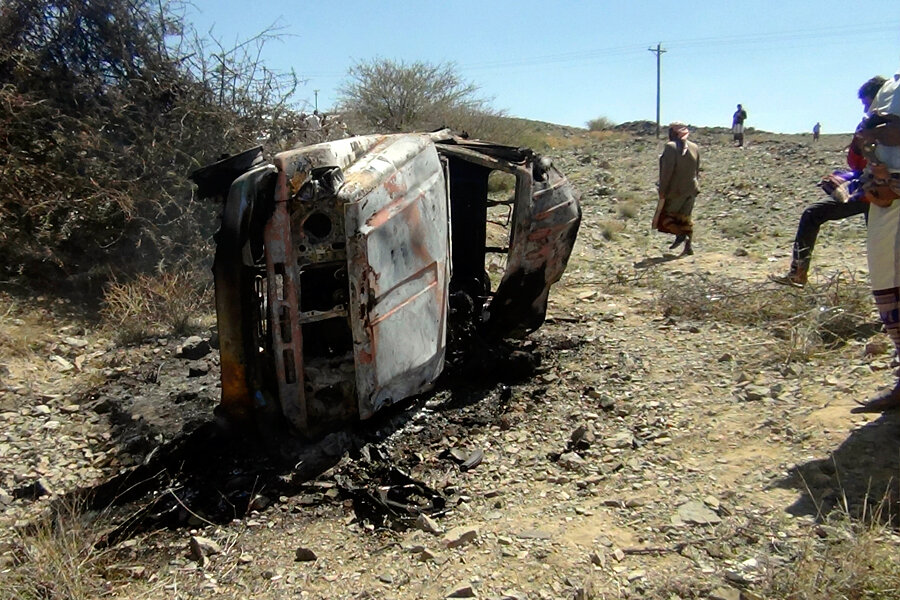String of US drone strikes in Yemen target Al Qaeda affiliate
Loading...
A daily roundup of terrorism and security issues
A series of drone strikes in Yemen in recent days have killed at least 40 alleged militants, highlighting the challenges facing the US and Yemen in directing a controversial anti-terrorism drone campaign that has proven effective in the past.
The Yemeni government has openly acknowledged a role in the strikes, despite the fact that it has made noise about decreasing the use of such airstrikes to combat Al Qaeda in the Arabian Peninsula (AQAP), a local Al Qaeda franchise.
Yemen's interior ministry announced that at least 55 militants were killed, while the US gave a more conservative estimate of 40-something. At least three civilians were also killed, The New York Times reports.
Both the US and Yemen had a hand in the strikes, of which there were at least three between Saturday and Monday. US officials told the Times that the airstrikes were carried out by the Central Intelligence Agency, but the agency would not comment. Other anonymous officials said that a US military special operations unit carried out support on the ground, but the Pentagon declined to comment as well. The White House has referred all questions about the operation to the Yemeni government.
The Ministry of Defense told the Yemen Post that the Yemeni Air Force carried out the operation with US drones.
The Times reports that the US is trying to allow Yemeni President Abdo Rabbu Mansour Hadi to take most of the credit for the operation to bolster his credibility. Mr. Hadi has publicly acquiesced to US drone operations in Yemen, in contrast to his predecessor, Ali Abdullah Saleh, who was a vocal critic.
But Yemen, too, was sparse on details of the operation, and Adam Baron, a correspondent in Yemen who writes for the Monitor, notes that this is negating American efforts.
Mr. Baron reports for McClatchy that the high rate of civilian casualties in drone strikes, particularly a hit in December that mistakenly targeted a Yemeni wedding party, has prompted a review of the US drone campaign, which is highly unpopular. But dissatisfaction is now coming up against an operation that could be considered a success, albeit a tainted one.
Still, the three days of attacks show the fragility of such goals. Saturday morning’s strike, for example, accurately hit an AQAP vehicle, according to government statements. Unfortunately, three civilian laborers who happened by in a separate vehicle were also killed.
“It would have been the perfect strike,” said another Yemeni official briefed on security matters, speaking on the condition of anonymity. He said the militants targeted by the attack had long been under surveillance. “Those poor laborers (drove in) just after the bombs were dropped.”
The backlash appears to have at least slowed the rate of such airstrikes in Yemen. The Long War Journal reported that there have been 11 strikes this year, including the four that happened this month, but that there were only 26 in all of 2013 – down from 41 in 2012.
A Reuters analysis throws cold water on the idea that the drone campaign can debilitate AQAP while Yemen itself changes little. Noting "a weak central government, a rivalry-ridden and poorly equipped security force, endemic poverty and corruption," it describes Yemen as "the ideal haven."
The drones' main success has been to severely limit AQAP's movements and ability to hold territory as it did back in 2011.
"When they move from A to B, they have to think 100 times. They've lost their freedom," said Mustafa Alani, a security analyst with close ties to the Saudi Interior Ministry.
"It (drones) is very effective, but this is not going to deal with the problem. These people are replaceable. You can kill 10 of them and there's 10 more in the pipeline. (So) it's a success that won't end the war against AQAP," he said.
Reuters also notes that when drone strikes cause civilian casualties – whether as a byproduct of a successful strike or directly because of inaccuracy or poor intelligence – they can increase popular support for militancy. Yemeni political scientist Abdulghani al-Iryani told the news agency that there was a "sharp increase" in Al Qaeda's numbers after the drone campaign began in 2003 – from a few hundred to an estimated several thousand now.
"The fact that both the Yemeni and the U.S. governments have relied too heavily on the use of drones as an expedient way to postpone the resolution of the problem rather than having a proper, comprehensive approach to the problem, has contributed to the expansion of al Qaeda in Yemen," Mr. Iryani said.
Given the Yemeni Army's weak grip in much of the country, drones are the easiest answer in the country, said Charles Lister, a visiting fellow at the Brookings Doha Center and expert in militant groups. Still, that doesn't mean it's an effective option:
"But the lack of on-the-ground military presence means a lack of localised intelligence, which by extension means strikes have inevitably struck civilian targets on occasion. In a deeply tribal and conservative society, such incidents are a recipe for disaster," he said.
"While a drone strike might represent one step forward, more often than not, it also means two steps back."
The Los Angeles Times reports that the strikes were a direct response to a boastful video of a large Al Qaeda gathering that occurred last month but began making US headlines only last week.
US officials linked the three airstrikes to a video that appeared on a militant website March 29. It showed [Nasser al-Wuhayshi, the head of Al Qaeda’s Yemeni branch] exhorting dozens of apparent followers of Al Qaeda in the Arabian Peninsula (AQAP) at an open-air gathering in southern Yemen’s Abyan province, the area targeted by two of the drone strikes.
In a speech to the group, Wuhayshi made clear that he was targeting the United States, saying, “We must eliminate the cross.... The bearer of the cross is America!”
“That video was alarming to people,” a former senior US diplomat said Monday. “The visuals were a bit more than people wanted to see promoted in terms of their ability to gather the faithful and put it all up on YouTube and thumb their nose” at the Yemeni government.








